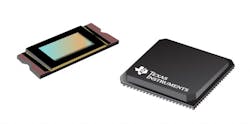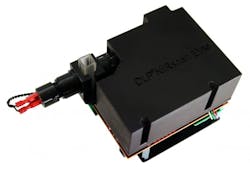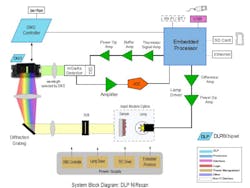Digital Light Processing Technology Optimizes Spectroscopy Applications
Spectroscopy has proven to be a powerful technique for recognizing and characterizing materials through their absorption and emission of light. Although there are numerous types of spectroscopy solutions, Texas Instruments’ (TI) Digital Light Processing (DLP) technology offers a novel single-element approach compared to conventional large-array architectures. TI recently announced a near-infrared (NIR) micro electromechanical system (MEMS) digital micromirror device (DMD), the DLP4500NIR, as well as the DLP NIRscan evaluation module (EVM).
It is optimized for use with 700- to 2500-nm light and can be programmed to select and attenuate multiple wavelengths at speeds up to 4 kHz. The technology further enables improved signal-to-noise ratios (SNRs) greater than 30,000:1 over a set period of time, providing more accurate results compared to traditional solutions. The device’s small-form factor offers greater flexibility, compared to expensive array detectors, in the creation of systems.
The DLP technology, in conjunction with broadband detectors across the VIS-NIR ranges, allows for the pre-dispersive selection of multiple wavelengths for high-speed transmission or absorption measurements. This enables the generation of dynamic measurement schemes and algorithms, gained speed and accuracy for critical applications, and the protection of samples from unnecessary exposure.
According to the white paper, “Texas Instruments DLP Technology for Spectroscopy,” by Pascal Nelson, “The unique architecture of the DLP DMD facilitates a spectrometer architecture that uses a larger, single detector to displace an expensive array detector, while still allowing for a robust (no moving parts) optical platform.” Nelson goes on to list other performance benefits including: a larger spatial area that supports a greater detector area and light- capture efficiency, the aforementioned better SNR, and the elimination of scan errors due to pixel defects thanks to the single-element detector approach.
The architecture also enables adaptive scanning techniques that are not possible with array detectors or rotating grating designs. Sample methods include auto SNR adjust/constant SNR scan, auto optical flux control, “on the fly” control of resolution and wavelength ranges, and chemometric methods with multiple patterns. This further helps in the overall design of high performance, robust, flexible, and cost effective spectroscopy solutions.
About the Author
Iliza Sokol
Associate Content Producer
Iliza joined the Penton Media group in 2013 after graduating from the Fashion Institute of Technology with a BS in Advertising and Marketing Communications. Prior to joining the staff, she worked at NYLON Magazine and a ghostwriting firm based in New York.



